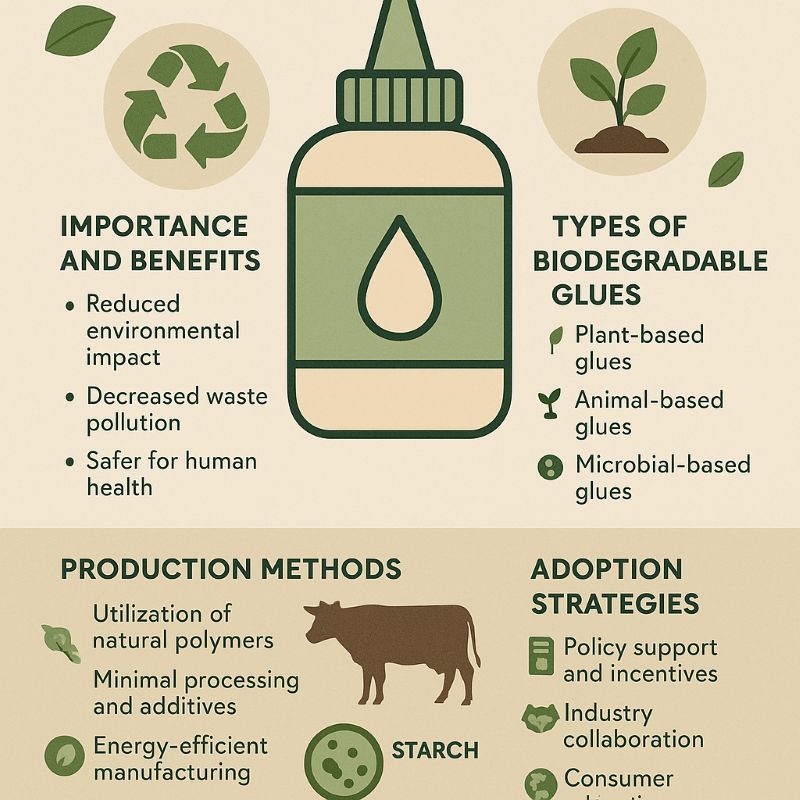
Defining Biodegradable Glues
Types of Biodegradable Adhesives
Importance of Sustainable Glues
Methods of Production
Latest Trends in Glue Technology
Strategies for Adoption
Future Prospects
Frequently Asked Questions (FAQ)
Biodegradable glues are adhesive solutions designed to break down naturally in the environment, reducing waste and minimizing ecological impact. Unlike conventional adhesives, which can persist for decades, these glues decompose into non-toxic components. Their rise demonstrates how sustainability and innovation are reshaping industries such as packaging, construction, and consumer goods.
Biodegradable adhesives encompass a variety of formulations tailored for specific applications. Some are plant-based, relying on starches or proteins for craft and light-use purposes. Others are packaging-grade adhesives, designed to secure cartons or wraps while still decomposing after disposal. There are also construction-grade formulations that provide stronger adhesion for heavier-duty applications while maintaining eco-friendly properties. This diversity highlights how different industries can adopt sustainable alternatives without compromising functionality.
Sustainable adhesives play a critical role in reducing pollution and conserving natural resources. Unlike synthetic glues that contribute to landfill buildup and chemical leaching, biodegradable variants degrade into harmless by-products, protecting soil and water systems. For industries, adopting these solutions not only minimizes environmental impact but also aligns with global sustainability goals. Choosing such adhesives reflects a long-term commitment to ecological health and corporate responsibility.
The production of biodegradable adhesives combines modern chemistry with ecological responsibility. Manufacturers often use natural polymers derived from renewable sources such as starch, cellulose, or plant proteins. Processes like enzymatic polymerization and bio-based cross-linking enhance adhesive strength while ensuring biodegradability. These techniques allow the adhesives to maintain performance standards while decomposing safely, thus balancing industrial utility with environmental stewardship.
Recent trends in adhesive technology show a strong move toward eco-conscious design. Biodegradable glues are at the forefront, benefitting from advances in natural polymer science and green manufacturing methods. Researchers are experimenting with new raw materials like algae-derived resins and bioengineered proteins, improving both adhesion and decomposition rates. As industries prioritize sustainability, these innovations are setting new standards in adhesive performance and eco-friendliness.
For industries considering biodegradable adhesives, the first step is evaluating current adhesive applications and identifying areas where sustainable alternatives can be substituted. Training staff on proper usage, establishing partnerships with reliable suppliers, and exploring government or consumer-driven incentives for sustainable practices are key strategies. By integrating biodegradable adhesives, companies not only reduce their ecological footprint but also enhance their reputation in markets that increasingly value green practices.
The future of biodegradable adhesives is promising. With growing consumer awareness, supportive regulations, and continuous research, these glues are poised to transform sectors such as packaging, construction, and education. As technology advances, the balance between strength, cost-effectiveness, and biodegradability will improve further. Ultimately, widespread adoption of biodegradable adhesives will be central to achieving long-term sustainability goals across industries worldwide.
What are biodegradable glues?
They are adhesives formulated to break down naturally into non-toxic components, reducing long-term environmental harm.
What types of biodegradable adhesives exist?
Common categories include plant-based glues for crafts, packaging-grade adhesives for cartons and wraps, and construction-grade formulations for robust applications.
Why are sustainable glues important?
They reduce landfill waste, prevent chemical leaching, and support global sustainability initiatives.
How are biodegradable glues produced?
They are made from renewable polymers such as starch or cellulose, often using eco-friendly techniques like enzymatic polymerization.
What are the latest trends in glue technology?
The use of algae-derived resins, bioengineered proteins, and advanced green chemistry methods are leading the way.
How can industries adopt biodegradable glues?
By assessing current adhesive use, integrating sustainable alternatives where possible, training staff, and working with suppliers to ensure consistency.
What does the future hold for biodegradable adhesives?
Wider adoption across industries, improved formulations, and stronger policy support will continue driving growth in this sector.
How do biodegradable glues benefit the environment?
They minimize landfill accumulation, reduce pollution, and protect ecosystems by breaking down safely after use.